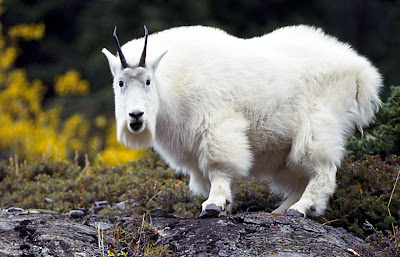 Mountain Goat is truly a part of the pronghorn gang. It has a gloomy appearance, long dark horns and a short tail. Both guys and females have facial hair like hair on their buttons. The mountain goat sports a cover of woolly, white hide that keeps it warm at high rises. This layer has a twofold layer for included warmth throughout winter the jacket sheds, or tumbles off, throughout June through August.
Mountain Goat is truly a part of the pronghorn gang. It has a gloomy appearance, long dark horns and a short tail. Both guys and females have facial hair like hair on their buttons. The mountain goat sports a cover of woolly, white hide that keeps it warm at high rises. This layer has a twofold layer for included warmth throughout winter the jacket sheds, or tumbles off, throughout June through August.
Mountain goats are not correct goats, they have a place with an assembly regarded as goat-eland. Unlike the furrowed, bended horns of accurate goats, the mountain goat's horns are just marginally bended and almost smooth. Their hooves have hard external shells and a rubbery, curved set of footpads that enactment as suction measures when they stroll in their nature's turf, and help pad their feet when they bounce from rock to shake.
Both male and female mountain goats have whiskers, short tails, and long dark horns, 15–28 cm (5.9–11 in) long, which hold yearly development rings. They are ensured from the components by their woolly white twofold covers. The fine, thick downy of their undercoats is secured by an external layer of more extended, empty hairs. In spring, mountain goats moult by rubbing against rocks and trees, with the grown-up bucks shedding their added downy first and the pregnant does shedding final.
Mountain goats are dynamic both throughout the day and night, yet require some investment to rest under overhanging bluffs. They chiefly live in crowds and move around consistent with time of year. In the hot time of year, more diminutive assemblies will fly out to salt licks. Females, called caretakers, use the vast majority of the year in crowds with their children, while guys either live alone or with 2 -3 different guys. Caretakers could be defensive of their domain and sustenance, along these lines will battle different babysitters in their crowds.
Mountain goats are the biggest well evolved creatures discovered in their high-height territories, which achieve heights of 13,000 feet (4,000 m) or more. In spite of the fact that they here and there plummet to ocean level in seaside zones, they are essential an elevated and sub alpine species. All through the year, the creatures more often than not stay above the tree line, however they will move seasonally to higher or lower heights inside that.







0 comments:
Post a Comment